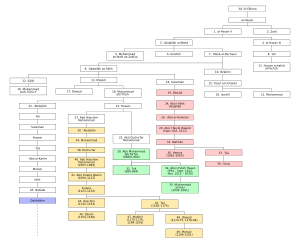
Back شريف مكة Arabic Jerife de La Meca AST Мәккә шәрифе BA মক্কার শরিফ Bengali/Bangla Xerifs haiximites Catalan Scherifen von Mekka German Jerife de La Meca Spanish Mekako xerife EU شریف مکه FA Chérif de La Mecque French

The Sharif of Mecca (Arabic: شريف مكة, romanized: Sharīf Makkah) was the title of the leader of the Sharifate of Mecca, traditional steward of the Islamic holy cities of Mecca and Medina. The term sharif is Arabic for "noble", "highborn", and is used to describe the descendants of Hashim ibn Abd Manaf.
The Sharif was charged with protecting the cities and their environs and ensuring the safety of pilgrims performing the Hajj. The title is sometimes spelled Sheriff or Sherif, with the latter variant used, for example, by T. E. Lawrence in Seven Pillars of Wisdom.
The office of the Sharif of Mecca dates back to the late Abbasid era. Until 1200, the Sharifate was held by a member of the Hashim clan,[1] not to be confused with the larger clan of Banu Hashim from which all Sharifs claim descent. Descendants of the Banu Hashim continued to hold the position until the 20th century on behalf of various Muslim powers including the Ayyubids and the Mamluks. In 1517, the Sharif acknowledged the supremacy of the Ottoman Caliph, but maintained a great degree of local autonomy. During the Ottoman era, the Sharifate expanded its authority northwards to include Medina, hitherto a sharifate of its own, and southwards to the frontiers of 'Asir, and regularly raided Nejd.
The Sharifate came to an end shortly after the reign of Hussein bin Ali, who ruled from 1908, who rebelled against the Ottoman rule during the Arab Revolt of 1916. After the defeat of the Ottoman Empire in 1918 and its subsequent dissolution in 1923, Hussein formed the independent Kingdom of Hejaz and then declared himself Caliph. The British granted control over the newly formed states of Iraq and Transjordan to his sons Faisal and Abdullah. In 1924, however, in the face of increasing attacks by Ibn Saud, Hussein abdicated his political titles to his eldest son, Ali bin Hussein, who was to become the last Grand Sharif. At the end of 1925, Ibn Saud conquered the Hejaz and expelled the Hashemites. The House of Saud has ruled Mecca and Medina and overseen the Hajj (annual pilgrimage to Mecca) since that time.[2]
- ^ "الأشراف الهواشم الأمراء - أشراف الحجاز". www.al-amir.info (in Arabic). Retrieved 17 March 2017.
- ^ "Ibn Saud reign of Hejaz – www.saudinf.com". Archived from the original on 1 March 2000.